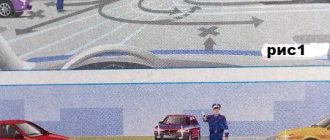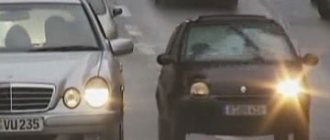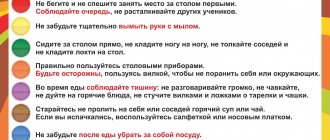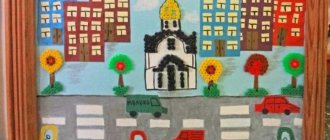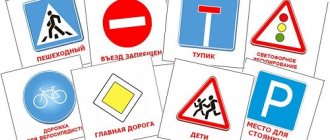Conversation on the topic: “Road Safety”
Consultation for parents
“How to develop safe behavior skills on the street”
One of the main reasons for road accidents with children is that children in their behavior on the street are guided by observations of the actions of adults in similar situations. Unfortunately, this action is not always correct. How to teach children to behave safely on the street? Just warnings like “be careful” will not help matters significantly. Daily training of the child’s movements and attention is necessary, combined with the constant personal example of the parents. Only in this case can children develop solid skills for safe behavior on the street.
Observation skill. The child must learn to see objects that block the view of the roadway as dangerous objects or hiding danger. To do this, he needs to repeatedly show these objects from the sidewalk when they hide, are about to hide, or have just hidden a moving car. In the same way, the child must learn to see distractions as danger signals. Such a factor could be a bus stopping on the opposite side of the street. Rushing towards it, people often fall under the wheels of passing cars. The reason is that their attention at this moment is switched only to their bus.
The skill of calm, fairly confident behavior on the street is developed through the personal example of parents. This skill is very important for a child, so an adult, walking down the street with his son or daughter, should not give in to excitement or haste, no matter what circumstances force him to do so.
The skill of switching to the street. The curbstone of the sidewalk is the boundary beyond which the habits that operate in everyday life end. It is necessary to teach the child to notice this boundary: to slow down, stop, and take the necessary pause for psychological switching in connection with the transition to the danger zone. And here the example of parents is crucial.
The skill of switching to self-control. Once on the roadway, the child must monitor his behavior and correctly assess the road situation. Developing such a skill requires some training under the guidance of a teacher and parents.
How should adults behave when outdoors with a child? If you are holding a child, be careful: he is blocking your view of the street. You cannot carry a child on a sled on or near the road. Such “transport”, as is known, easily tips over. When traveling in a taxi, it is necessary that passengers with children sit in the back seat - as prescribed by the Traffic Rules. Also take into account the possibility of sudden braking and protect your child from injury. When disembarking, adults must leave first and receive children. The bus is approaching the stop. Until the bus stops moving completely, you should not approach it; a child (like an adult) can trip and get run over, especially if there are a lot of passengers at the stop. The stopping zone is a dangerous place for a child. The fact is that a standing bus reduces the view of the Road in this area, both for drivers of passing cars and for pedestrians. In addition, pedestrians here are often in a hurry and a child can be pushed onto the roadway. Even an experienced driver cannot always avoid sudden braking in an emergency situation. Therefore, when traveling on public transport, you must ensure that the child is in a stable position. You need to be especially careful near the driver’s cabin and when preparing to exit. Adults are always the first to get off the bus, trolleybus, or tram and receive the child. If you let children go ahead, they can break free from your arms and run out onto the road, and a small child, walking on steps designed for an adult, can fall. When walking down the street hand in hand with a child, do not forget that the child may try to break free. This is a common cause of childhood road injuries. Teach children to observe. It is from the age of two to seven, while he is on the street next to you, that it is best to instill in him the skills mentioned above. Use every occasion of being on the street with your child to teach him to see and guess typical road “traps”. When crossing the street, let him also observe, and not just trust you. Otherwise, the baby will get used to walking across the street without looking. Do not allow your child to run ahead of you at the end of the crossing. This reinforces the same habit of moving along the street without observing the traffic situation. If your child wears glasses, he can only see well in front of him, and on the street, so-called peripheral vision plays an important role. Since it remains weakened, special care must be taken to teach the child to correctly assess the speed of approaching traffic, to recognize typical situations of obstructed vision and distraction. When walking down the street with a child, do not rush on the roadway, run across the road to the bus, talk about strangers while crossing, move at a red traffic light or make a prohibiting gesture from a traffic controller.
Conversation “The road is dangerous”
Topic: “The road is dangerous ”
Tasks:
Teach children to respond quickly in emergency situations.
To form public awareness of citizenship about dangers on the road, in the children's park and near home.
To cultivate in children attention, sensitivity, responsiveness, and the ability to help others.
Equipment: road sign, landscape sheet, pencils and markers, toys or pictures with images of a bunny and a squirrel.
Preliminary work: examination and familiarization with road signs, conversation about traffic rules.
Vocabulary work: street, road, edge, transition, swing, bruise.
1. Introductory conversation by the teacher.
Wherever you are, in a big or small city, in a village, in a village - everywhere you will find roads. And for the road to be safe, we must follow the traffic rules.
Let's remember how to walk down the street and cross the road? (Children's answers)
What rules do you know for pedestrians?
2. Today we will meet our friends again: a little squirrel and a little hare, and we’ll listen to what unforeseen circumstances they found themselves in.
3. Listening to a fairy tale
The little squirrel and the little hare decided to go to the children's park and ride on the swings there. The children's park was located behind the forest. Having reached the edge of the forest, the friends saw that it was not immediately possible to get into the park. To do this you need to cross a wide street. The little hare suggested running across the street between the cars that were racing along the road. But the little squirrel was very attentive: he noticed a road sign nearby that allowed crossing. Following this sign, the friends crossed the street without fear and found themselves in the park. (Physical minute)
The friends sat on the swing. The little squirrel fastened his seat belts, and the little bunny decided that it would do just fine. And then the swing swayed..... The little bunny couldn’t resist and fell out. The little squirrel acted very quickly. He called 03, called an ambulance, and he reassured his friend that everything would be fine and everything would work out. The doctors, having examined the little hare, said that, fortunately, the bruises were minor and, after scolding him, they sent his friends home.
4. Conversation on what you read.
Did you like the fairy tale? What kind of trouble could friends meet on the road? Why did the little bunny fall out of the swing? How did the little squirrel act?
5. Practical work
Which road sign told your friends where to cross the road?
Let's draw it now.
6. Conclusion
This road sign is an assistant to pedestrians, and they should be friends with it.
There are many different road signs on the streets and roads. They are the best assistants and friends for drivers and pedestrians; they tell you what the road is like, how to drive, what is allowed and what is not allowed. Be careful on the roads, guys!

